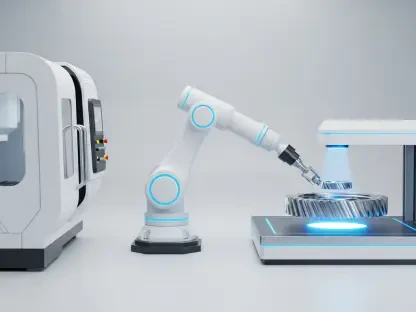The 5G Industrial Internet of Things (IIoT) stands at the vanguard of a revolutionary wave that is reshaping the industrial world. This evolution is not merely about the pervasive spread of machines and sensors; it’s about an intricate dance of connectivity, intelligence, and lightning-fast data analysis. The marriage of industry with the prowess of 5G technology beckons a future where factories and plants are not just collections of machinery but symphonies of synchronized digital ecosystems. Through this discourse, we’ll travel across the landscape of innovation, market rivalries, and the various facets that contribute to the 5G IIoT narrative.
Unleashing Potential with 5G in IIoT
The adoption of 5G technology within industrial precincts is more than an upgrade—it’s a complete redefinition of capabilities. This integration promises a level of efficiency and precision that was once the stuff of science fiction. With ultra-fast data transfer and minimal latency, 5G is unlocking a realm of possibilities for IIoT, ultimately transforming enterprises to be more responsive, agile, and smart.
Transformation in Manufacturing and Industrial Processes
The leap to 5G IIoT ushers in a drastic transformation in traditional manufacturing and industrial mechanisms. No longer constrained by slow communication speeds and inaccurate data, manufacturers are embracing 5G to facilitate predictive maintenance and automated control systems. Predictive maintenance, which leverages real-time data to foresee equipment failures before they occur, can now operate with precision, courtesy of 5G’s swift and reliable data transmission. This predictive prowess is revolutionizing the cost and efficiency of maintaining industrial machinery. Similarly, automated control systems are also becoming extraordinarily refined, contributing to safer, more efficient, and smarter industrial operations.
Smart Sensors and Actuators: The Building Blocks of IIoT
Smart sensors and actuators are the linchpins of the IIoT, serving as critical conduits for the myriad streams of data that keep digital industries pulsing. These devices collect and act upon data within the industrial setting, enabling a new dimension of automation. Smart sensors, for instance, are the watchful eyes that gather environmental and operational data in real-time. Actuators, on the other hand, are the arms that perform physical tasks based on the sensor data, closing the loop of a responsive, self-optimizing system. The seamless interplay of these components within the connected environment of 5G IIoT creates an ecosystem that is not only aware of its internal operations but can adjust and adapt with little to no human intervention.
The Titans of the 5G IIoT Arena
In a race ripe with potential and profit, stalwarts from technology and telecommunications are fervently innovating and strategizing to carve out predominant positions in the 5G IIoT landscape. This competitive fervor is driving a surge in R&D investment, groundbreaking solutions, and partnerships that could redefine industrial connectivity.
Technology and Telecommunication Giants Lead the Charge
Titans such as Qualcomm Technologies, Ericsson, and Huawei Technologies are at the forefront of the charge. These firms are the architects of foundational 5G technologies that serve the expanding universe of IIoT. By pushing the envelope of what’s possible, they are not only innovating within their spheres but also setting the stage for the entire ecosystem to level up. Meanwhile, AT&T and Cisco Systems, are shaping the future with their industrial solutions, crafting the networks and infrastructure crucial for a robust and secure IIoT platform. These companies are at the heart of the industrial revolution, providing the tools and technologies that enable industries to leap into a new era of efficiency and connectivity.
Strategic Alliances and Market Expansion Tactics
Strategic alliances have become a currency of growth in the hyper-competitive world of 5G IIoT. For companies like Siemens AG, Microsoft Corporation, and Honeywell International, collaboration, acquisition, and synergy are the cornerstones of their strategies. These companies understand that to lead in this space, they must blend their strengths with the cutting-edge technologies of nimble startups and specialized entities. As the market expands, these strategic moves are not just about cornering market share; they’re about shaping an ecosystem that can thrive amid the demands of diverse industrial landscapes.
Market Segmentation and Diversity
The 5G IIoT marketplace is a vast mosaic, segmented not just by components and services but also by the wide variety of applications and the industries they serve. This diversity is a testament to the adaptability of the technology, as well as its scalability – two qualities that ensure the relevance of 5G IIoT across market segments.
Components, Services, and Industrial Applications
The market offers a spectrum of components spanning hardware, solutions, and service segments. Hardware, such as sensors and network devices, forms the physical backbone of 5G IIoT, while software platforms handle complex tasks such as data analytics and device management. Services round out the offering with operational support and expertise that enterprises need to ensure smooth adoption and continuous optimization. The 5G IIoT ecosystem is also rich in applications that range from real-time workforce management to sophisticated business process optimization, each addressing the unique challenges found in various industrial sectors.
Scalability for SMEs and Large Enterprises
Providing scalable solutions is pivotal for the adoption of 5G IIoT across businesses of varying sizes, from SMEs to large enterprises. The ability to integrate technology at different levels allows smaller businesses to benefit from increased operational efficiency and opens the door for large-scale enterprises to exploit the full potential of automation and data analytics. The customization and scalability of solutions have made it possible for enterprises to embark on their unique digital transformation journeys, armed with the power of 5G IIoT to guide them toward enhanced productivity and profitability.
Pioneers and Growth Markets in 5G IIoT
Regions around the world are at different stages of embracing the 5G IIoT wave, with North America and Europe leading the way, and the Asia-Pacific region not far behind. Each region’s approach to adoption and growth reflects its industrial priorities and readiness for this transformative technology.
Early Adopters: North America and Europe’s Advantage
North America and Europe have leveraged their advanced infrastructure and proactive approaches to early 5G adoption to gain a pioneer’s advantage. In the United States, investments are robust, particularly in smart manufacturing, where 5G IIoT is starting to make a substantial impact. Such investments are not limited to the private sector; government initiatives are also playing a significant role in fostering the growth of this technology, indicating broad-based support for 5G IIoT.
Asia-Pacific and Beyond: Regions with Immense Growth Potential
The Asia-Pacific region is poised for a rapid ascension in the 5G IIoT arena, bolstered by significant investments in infrastructure and industrialization, particularly in tech-forward nations like China, Japan, and South Korea. This region’s commitment to adopting modern technologies portends well for its future as a competitive player in the industry. Growth in regions such as Latin America, the Middle East, and Africa is more measured, as they integrate 5G IIoT at a pace that aligns with their industrial capacities and investments, yet they hold potential as emergent contributors to the global market.
Growth Drivers and Key Market Strengths
Several key factors, including operational optimization needs and the rapid proliferation of connected devices, are fueling the market’s appetite for 5G IIoT. The synergy of this technology with advancements like AI and machine learning is setting the stage for a market ripe with innovation and sustained growth.
Escalating Adoption and Connectivity Requirements
The relentless pursuit of operational excellence drives industries towards the adoption of 5G IIoT solutions. This is further necessitated by the growing number of devices needing connection within the industrial setting, which 5G is uniquely qualified to support. Enhanced connectivity is the linchpin for a host of innovative applications that demand real-time data analysis and decision-making, which can be serviced only through a robust and capable network like that offered by 5G.
Synergy with AI, Edge Computing, and Emerging Technologies
The convergence of AI, machine learning, and 5G IIoT is propelling the market forward, bringing with it a dawn of unprecedented analytics and capability. Edge computing complements this by processing data at the source, reducing latency, and conserving bandwidth. This synergy is brewing an innovation storm, showcasing the endless possibilities of an interconnected industrial future where data and machine intelligence blend to enhance operational efficiency and productivity.
Potential Setbacks and Resilient Market Dynamics
Despite a generally favorable forecast, the 5G IIoT market faces potential headwinds such as economic downturns, which could impact investment and capital expenditure. However, the resilience inherent in the market’s dynamics suggests an ability to weather these challenges effectively.
Economic Downturns and Fiscal Challenges
Economic slowdowns invariably affect corporate spending, but the essential pursuit of efficiency and cost savings could well bolster the adoption of 5G IIoT technologies even in such times. In an environment where resource optimization becomes imperative, investments in systems that enhance productivity and reduce waste remain a priority for enterprises looking to navigate financial hurdles.
Government Stimulus and Long-term Industrial Advantages
Government intervention often provides a buffer against fiscal downturns. As part of strategic infrastructure and industrial policy, stimulus measures can sustain progress within the 5G IIoT sector. Additionally, a focus on long-term industrial advantages, such as increased productivity and energy efficiency, incentivizes ongoing investment in this technology, aligning it with broader economic and environmental goals.









